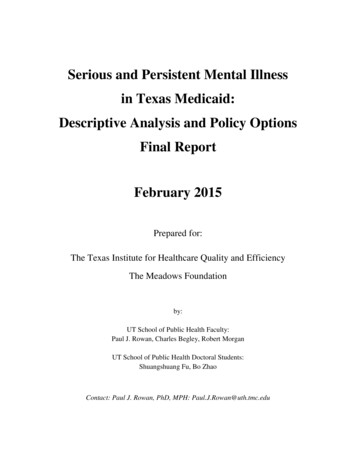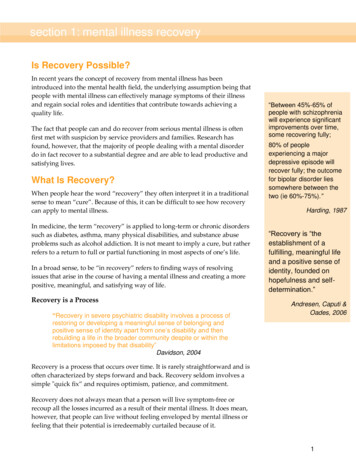
Transcription
Serious and Persistent Mental Illnessin Texas Medicaid:Descriptive Analysis and Policy OptionsFinal ReportFebruary 2015Prepared for:The Texas Institute for Healthcare Quality and EfficiencyThe Meadows Foundationby:UT School of Public Health Faculty:Paul J. Rowan, Charles Begley, Robert MorganUT School of Public Health Doctoral Students:Shuangshuang Fu, Bo ZhaoContact: Paul J. Rowan, PhD, MPH: Paul.J.Rowan@uth.tmc.edu
Serious and Persistent Mental Illness in Texas Medicaid:Descriptive Analysis and Policy OptionsFinal ReportTable of ContentsExecutive Summary . . 03 . . .09 . .13 . .42IV. Clinical Best Practices for SPMI Care . .53V. State Policy Options for SPMI Care .58 .62Appendix: Citations for Clinical Best Practices of SPMI Care . 63I. Data Acquisition and LinkageII. Analysis of Medicaid Claims, Encounter, and Enrollment DataIII. Interviews with Providers in LMHAsLiterature Cited.2
Serious and Persistent Mental Illness in Texas Medicaid:Descriptive Analysis and Policy OptionsFinal ReportExecutive SummaryThe primary goals of this project were to: 1) obtain and link Medicaid and Medicareacute care data from the Texas Health and Human Services Commission (HHSC), long termservices and support data from the Texas Department of Assistive and Disability Services(DADS), local mental health authority (LMHA) and state hospital data from the TexasDepartment of State Health Services (DSHS), and hospital discharge data from DSHS; 2) use thelinked data to describe the severe and persistent mental illness population using state servicesand their utilization patterns and costs; and 3) interview providers and health plan administrators,and review literature and websites, to identify service delivery issues and best practices for thispopulation.To achieve the first objective the UTSPH research team has been working with theInstitute for Healthcare Quality and Efficiency (IHCQE), DADS, and DSHS staff to gaininstitutional review board approvals, data use agreements, determine techniques for data transferand receipt, understand the structure and content of each data set, and link them for analysis. Asof the writing of this report, three of five data sets -- Medicaid acute care, Medicare acute care,and LMHA/state hospital data -- have been obtained and linked. Approvals have been obtainedto receive the remaining two data sets, and data consolidation and transfer processes are ongoing.Preliminary analyses of the linked data have been completed and findings are reportedhere with respect to the number and characteristics of individuals with SPMI who are in eachdatabase, their enrollment patterns, and their medical conditions.Interviews were carried out with representatives of nine LMHAs and one health planadministrator in order to understand service gaps and how care might more optimally bearranged and funded. There was also a focus on the transition of behavioral health intensive casemanagement and rehabilitation services to managed care. Provider representatives were selectedto include those in rural as well as urban service areas, in established integrated care systems,3
and providing care to persons dually diagnosed with intellectual disability as well as mentalillness.Thirty-one recent review articles summarizing evidence-based clinical best practices forpeople with SPMI were identified and examined. The summaries focused on outpatient care andthe array of services that could be adopted by a care team, treatment center, or local mentalhealth authority. Literature summarizing opportunities for reforming care for this populationcreated by the Affordable Care Act, as well as under Medicaid waiver programs, was alsoreviewed. A web search was conducted to discover innovative state models of health servicedelivery and/or financing for the SPMI population. Results were reviewed and summarized.FindingsSPMI PopulationUsing the Medicaid claims/encounters and enrollment data, and defining a Medicaidenrollee with SPMI as an individual who had at least one Medicaid service claim or encounterfor schizophrenia, major depression, or bipolar disorder, there were 288,355 adults with SPMI 18 years old, enrolled in Medicaid during 2010-2012.1 This represented 4.3% of the totalenrolled Medicaid population for that period and 10.8% of the total adult ( 18 years old)Medicaid population.Compared to the Medicaid adult population, enrollees with SPMI were more likely to beWhite (42.6% versus 28.1%), and less likely to be Hispanic (26.9% versus 46.8%), less likely tobe female (64.8% versus 73.2%), and more likely to qualify for SSI (72.2% versus 27.0%). Onaverage, SPMI enrollees were approximately five years older than non-SPMI enrollees (46.6years versus 41.0 years). Of Texas Medicaid patients with SPMI, 42.3% were also enrolled inMedicare (dual eligibles) between 2010 and 2012, with 31.5% using LMHA/state hospitalservices. Nine percent (9.0%) were both dual eligibles and used LMHA/state hospital services.Persons with SPMI who were dual eligible were more likely to be White (49.3% versus 37.7%),1Our definition is similar to that used in the research literature to identify the SPMI populationusing coded claims/encounter data. The definition may be adjusted as more data are acquired to reflectother diagnostic categories, severity of illness, and/or intensity of service use.4
and less likely to be African American (20.0% versus 23.5%) or Hispanic (24.3% versus 28.9%).They were approximately 11 years older than SPMI patients not in Medicare (58.8 years versus37.6 years). Those who used LMHA/state hospital services were approximately seven yearsyounger (42.0 years versus 48.7 years) than those who did not, and were more likely to beAfrican American (27.5% versus 19.5%), and less likely to be White (38.3% versus 44.6%) orHispanic (22.8% versus 28.9%). Patients in both groups were more likely to be SSI eligible.Medicaid enrollees with SPMI were enrolled for an average of 21.2 months during thethree year period; 9.8% had at least one gap in enrollment and another 1% had multiple gaps.The average length of enrollment gaps was 7.3 months. SPMI enrollees over the age of 65, nonSSI enrollees, women, and African-Americans and Hispanics were more likely to have gaps incoverage.Texas Medicaid enrollees with SPMI were more likely than non-SPMI enrollees to haveone or more of 13 major medical comorbidities (49.1% versus 36.4%), and more likely to havetwo or more of these comorbidities (27.2% versus 19.4%). Texas Medicaid enrollees with SPMIpatients enrolled in Medicare were more likely than non-Medicare enrolled SPMI patients tohave comorbidities (77.8% versus 42.2%, respectively, had one or more of the comorbidities),while patients using LMHA/state hospital services were less likely to have comorbidities (47.6%versus 61.8%).Best PracticesThe interviews with LMHA providers indicated the following concerns and suggestedresponses.Concerns: Service coverage and payment rigidities. Delays in processes of approval and payment for services. Low reimbursement rates. Overall burden and lack of standardization of performance reporting requirements. Requirement that counselors seeking reimbursement for cognitive-behavioral therapypass the DSHS CBT competency test. Lack of coverage of wide-range of service needs of the SPMI/IDD population.5
Resource gaps and barriers to care, particularly in rural areas.Suggested Responses: Designate one state agency to conduct oversight of care to people with SPMI. Review performance metrics and determine methods for streamlining and standardizing. Develop separate performance metrics for the population of people with SMI/IDD. Continue and expand state support for integrating physical and behavioral healthcare,expand and integrate peer specialists and community health workers into behavioralhealthcare, and expand availability of telemedicine and medical transportation,particularly in rural areas. Provide incentives for clinics to hire bilingual staff. Conduct a collaborative study to examine the health benefits of Medicaid enrollees withSPMI moving from SPMI-specific care into integrated care. Pilot a pay-for-performance model in integrated clinics for care of SPMI patients.The selected articles identified through the literature search provide evidence supportingthe following types of services and service arrangements as best practices in care for patientswith SPMI. Integrate regular medical care with psycho-education and support groups. Deliver services by telemedicine. Develop care components that empower patients and provide training in self-care. Develop interventions aimed at sustaining or repairing the social life of the patient,including housing assistance, occupational training, community mental health teams, andcrisis intervention services.Policy OptionsResults from the web search of policy innovations in other states revealed the followingtypes of strategies for improving care of the SPMI population: Reforms in Medicaid and/or Medicare payment and coverage,6
Task forces/advisory councils/oversight commissions to oversee state programs servingpersons with an SPMI diagnosis, and Data analytic centers to provide consistent, comprehensive data collection and evaluationof state programs.Potential opportunities created by the Affordable Care Act and related changes in federallaws and regulations related to Medicaid are the following: Coverage requirements for preventive healthcare services, including screening for alcoholabuse problems and depression, require Medicaid plans designed for the expansionpopulations to cover these services without cost-sharing, while for traditional Medicaidpopulations the federal government will pay for an additional one percent of the cost. Medicaid Health Home initiatives receive additional federal funds to integrate preventiveand wrap-around services into whole-person care teams. The Centers for Medicare and Medicaid Services (CMS) State Innovation Models (SIM)Initiative. Provides funding support for the development and testing of state-basedmodels for multi-paper payment and healthcare delivery system transformation. Projectscan focus on high risk populations with behavioral health problems. Changes in CMS rules for home and community based waivers eliminate institutionallevel of care requirement, expands the population that can be served, expands financialeligibility requirements, offers more flexibility to states to target services to specificpopulations based on diagnosis, age, disability, or coverage group, expands the servicesstates can provide under this option Changes in CMS rules allowing reimbursement for preventive services provided by nonlicensed practitioners (CHWs, peer counselors, etc.).Conclusions and RecommendationsBased on the preliminary analyses completed with the data sets received, the total numberand characteristics of enrollees with an SPMI diagnosis in Texas Medicaid were reported, theirmost prevalent diagnoses and co-morbidities, enrollment gaps, predictors of enrollment gaps,their enrollment in SSI and Medicare, and their use of LMHA/state hospital services.7
From the experience acquiring these data sets, a number of challenges were identifiedthat suggested the need for streamlining and standardizing access to and linkage of statedatabases. The following recommendations are offered to improve the state’s capacity for morecomprehensive evaluation of state programs serving people with SPMI.1. A data center for healthcare administrative data sets including staff dedicated to receivingand managing these data, and providing technical assistance to internal and externalresearchers and analysts.2. The data center should develop a standard process for external analysts to access thesedata.3. The center should collaborate with external analysts/institutions that have the capacityand expertise to handle these functions, and have the capacity and expertise to conductstatewide research projects with these data, including as requested by state agencies.The qualitative information obtained from provider and payer interviews and literatureand web searches provided a number of important concerns and potential strategies forimproving services to the SPMI population. Since cross-system data analyses have not yet beenconducted, and additional interviews with payers and providers are to be completed, it ispremature to draw broad conclusions or make specific recommendations regarding clinical bestpractices or policy options at this time.8
Serious and Persistent Mental Illness in Texas Medicaid:Descriptive Analysis and Policy OptionsFinal ReportI. Data Acquisition and LinkageWith assistance from the board and staff of the IHCQE, and the staff of the HHSC,DADS, and DSHS, the UT SPH research team has been obtaining state-level healthcareadministrative data sets in order to assess the services delivered by various state agencies topeople with serious and persistent mental illness (SPMI). The process of acquiring the data setsinvolves multiple steps including: obtaining all required IRB approvals from participatinginstitutions to request, obtain, and analyze data sets; requesting the data sets from various stateagencies and offices and developing signed agreements to receive them; receiving and securelymaintaining the data sets; understanding and preparing the data sets for analysis; and making thedata available to analysts. The process has been complicated by the diversity of requirements andprocedures in the different agencies. In some cases it has been challenging to learn what steps areinvolved and who should be contacted to develop data-sharing agreements and IRB approvals.Brief descriptions of the data acquisition processes, challenges, and current status are providedhere.The first step was obtaining IRB approval from the UT Health Science Center HoustonInstitutional Review Board. Following that, parallel processes were undertaken to access each ofthe data sets:Medicaid Acute CareUT SPH had the necessary approval to receive Medicaid data from HHSC, and had someof the Medicaid files. Medicaid NorthSTAR data was obtained and linked during the study.Current files: The Medicaid administrative dataset includes eligibility, enrollment,encounter and claims information for individuals enrolled in the program from September 2007through August 2012, although data from NorthSTAR is available only for 2011 and 2012. In2011, Medicaid covered approximately 14% of the individuals in Texas. The dataset includesindividuals enrolled in the Medicaid program on a monthly basis.9
The claims files have information for all medical claims for individuals in fee for service(FFS) plans as well as PCCM. For those under capitation the information on utilization is in aformat known as Encounter files. The Medicaid data include information on types of servicesused (inpatient, outpatient, professional, and pharmacy), dates of service, primary and secondarydiagnosis, procedures, providers and dollar amounts charged and paid.Medicare Acute CareUT SPH had approval from HHSC to receive Texas Medicare data. However, it wasdetermined that an HHSC amendment to the DUA was needed. The revised DUA wasdeveloped, reviewed by legal staff at UT SPH and HHSC, and signature-approval obtained fromofficials at both institutions.Current files: The Medicare administrative data files are for all Texas Medicarebeneficiaries (enrollees) for calendar years (CY) 2010 through 2013. Only data from 2010through 2012 were analyzed for this report. The dataset includes demographic, enrollment,inpatient, outpatient (including durable medical equipment etc.), and skilled nursing data. Ifindividuals are enrolled in a Medicare Part D (pharmacy) plan, those data are available as well.Utilization data are available for individuals enrolled in Medicare Parts A and B (Medicare FFS).This comprises approximately 80% or more of Texas Medicare beneficiaries during this period.For individuals enrolled in Medicare Part C (Medicare Advantage), data are limited tobeneficiary summary information, including demographic data and enrollment data. The data forinpatient, outpatient, skilled nursing, or other provider claims services are not complete.Individuals may also have Medicare Part D (pharmacy) data if they were also enrolled in aMedicare Part D plan during this period. The Medicare data include information on types ofservices used, dates of service, primary and secondary diagnosis, procedures, providers, anddollar amounts charged and paid.DADS Long Term Services and SupportsA DUA was developed and approved by the legal departments of UT SPH and DADS.An “action memo” was developed from the appropriate DADS office. A data security plan wascompleted and approved by the UT Health Sciences Center Chief Information Security Officeand DADS IT staff and other DADS officials. The data are being prepared for transfer.10
DSHS LMHA and State Hospital DataWith the assistance of staff at DSHS, the following data request and IRB forms weresubmitted to obtain 2010 to 2012 LMHA and state hospital utilization and payment data for theMedicaid SPMI population.1)2)3)4)5)6)7)8)Approval-to-Apply Request to Deputy Commissioner;Medicaid Clients Variable List with requested variables for clients with Medicaid IDs;Research Protocol;Initial IRB Application Form;Documentation of Training in the Conduct of Research with Human Subjects;Disclosure of Potential Conflicts of Interest;Request for Waiver of Consent or Authorization – HIPPA;IHCQE Letter of Support.The data request and IRB forms were provided by DSHS staff to the UT SPH team inmid-February and prepared and submitted in mid-March. The data request and IRB forms werereviewed by DSHS staff and forwarded for approval in mid-April. The data request wasapproved by the Executive Committee in June. The HIPAA Waiver of Authorization wasapproved in mid-May and the IRB application was approved in June. All approval signatures onall forms and the final approval letter were obtained in late July. The data were pulled by DSHSstaff and transferred to UT SPH in October 2014.Current files: The LMHA/state hospital data contains encounters and services for allTexas Medicaid enrollees for 2010 through 2012. Data include demographic, level of care,inpatient, outpatient, and pharmacy services received. This includes information on types ofservices used, dates of service, primary diagnosis, procedures, providers, and event costs.Although these files were restricted to Texas Medicaid enrollees, they include data onLMHA/state hospital services received by those individuals during gaps in their Medicaidenrollment.Texas Hospital Discharge DataA UT SPH request to obtain THCIC hospital discharge data for linkage to Medicaidclaims was initially declined. Another request for IHCQE to obtain the data was developed anda plan for DSHS staff to perform the linkage. The IHCQE request was submitted and approved.The linkage process involved UT SPH generating a list of Medicaid-enrolled individuals and11
DSHS staff performing the linkage with hospital discharge data. DSHS staff are completing thelinkage at the time of writing this report.Summary and RecommendationsWith the support of the IHCQE and the Meadows Foundation, the UT SPH in Houstonhas been acquiring and linking state-level administrative data to determine the patterns of careand costs for Medicaid members with an SPMI diagnosis that are provided through multipleagencies. The process of obtaining the data sets has been slow and difficult, despite the good willand assistance from the involved agencies. For each agency, there is a separate, unique processfor ascertaining executive approval, ascertaining IT security approval, and ascertaininginstitutional review board approval. In some cases there are statutory barriers, for example datausage fees, that further impede access to data.In order to assess health care performance, the long-term goal of the State of Texasshould be to have comprehensive and integrated administrative data sets of high quality that isavailable for policy analysts, both inside and outside state government, to evaluate thefunctioning of publically-funded healthcare programs and services, and to evaluate the impact ofadministrative and policy changes. From our experience acquiring data sets for evaluation ofservices to the population of people with SPMI, the following preliminary recommendations areoffered:1.A central data repository center for state-level administrative data sets should beestablished; this should include staff dedicated to receiving and managing these data, andproviding technical assistance to internal and external researchers and analysts.2.The center should develop a single process for accessing these data by externalinvestigators.3.The center should collaborate with academic institutions that have the capacityand expertise to handle these functions, and have the capacity and expertise to conductstatewide research projects with these data, including as requested by state agencies.12
II. Analysis of Medicaid Claims, Encounter, and Enrollment DataIdentification of CasesIn the Medicaid data set, persons with SPMI were identified based on primary SPMIdiagnosis code for Medicaid services noted in the Medicaid claims and encounter data duringstate fiscal years 2010 through 2012. Our analysis plan has been restricted to adults, so we haveonly developed analyses for persons 18 and older. The diagnosis codes used for caseidentification are shown below in Table 1. They are commonly used in the SPMI-relatedliterature and focus on the three most severe diagnostic categories: schizophrenia, majordepression, and bipolar disorder. If desired, other diagnosis categories can be included in futureanalyses.When we began this project, we reviewed existing literature to identify a consensuscriteria set for identifying a population of individuals with an SPMI diagnosis in administrativedata; our findings were that there is no consensus, but the varied criteria were fairly concordant.Our definition is representative of those used thus far. In the future, this can be adjusted,including targeting those with more debilitating illness, or those with greater utilization intensity.We used primary diagnoses only for identifying the Texas Medicaid SPMI population.There are notable reporting differences between the claims and encounter files, with secondarydiagnosis codes not reliably available in the encounter data. The primary diagnosis code is theonly consistent diagnostic indicator across both the claims and encounter data files.Table 1. ICD-9 Codes Used to Identify Medicaid Enrollees with SPMIICD-9CodesDescription295.0xSimple type schizophrenia295.1xDisorganized type schizophrenia295.2xCatatonic type schizophreniaschizoaffective295.3xParanoid type schizophreniadisorder295.4xSchizophreniform disorder295.5xLatent schizophrenia295.6xSchizophrenic disorders, residual typeSchizophrenia,including13
Major depressive295.7xSchizoaffective disorder295.8xOther specified types of schizophrenia295.9xUnspecified type schizophrenia296.2xMajor depressive affective disorder single episode296.3xMajor depressive affective disorder recurrent episode311Depressive disorder not elsewhere classified296.0xBipolar disorder, single manic episode296.1xManic affective disorder recurrent episode296.4x296.5xBipolar disorder296.6x296.7xBipolar disorder, most recent episode (or current)manicBipolar disorder, most recent episode (or current)depressedBipolar disorder, most recent episode (or current)mixedBipolar disorder, most recent episode (or current)unspecifiedBipolar disorder/atypical manic disorder/atypical296.8xdepressive disorder/other and unspecified bipolardisorders, other296.9xUnspecified episodic mood disorder/other specifiedepisodic mood disorderIndividuals with SPMIAs Table 2 shows, there were 288,355 separate individuals, 18 years old, who had atleast one claim or encounter with a primary SPMI diagnosis in 2010 to 2012. This populationrepresents 10.8% of the adult Medicaid population. As noted above, data obtained forNorthSTAR enrollees were only available for 2011 and 2012. Medicaid patients identified asSPMI through the NorthSTAR data represent approximately 3% of SPMI patients included inthis report. As we gather and analyze additional data sets, as planned and underway, we maydetermine that there are more individuals who fit the SPMI definition.14
The diagnostic breakdown of this population of Medicaid patients with SPMI is shown inTable 2. Major depression accounted for almost half (43.6%) of all cases, followed byindividuals with bipolar disorder (31.2%). This category includes individuals with either abipolar diagnosis alone, or with both depression and bipolar diagnoses. Depression is acomponent of bipolar disorder, consequently the joint identification of these categories is likelyidentifying bipolar individuals, with providers on some occasions or settings choosing to codedepression for that patient. We have kept those with a diagnosis of both bipolar disorder anddepression separate in this analysis in order to reflect how they were identified in the data.Table 2. Number of Individuals with SPMI, by Year and Overall, for Texas AdultMedicaid Enrollees: State Fiscal Years 2010, 2011, and 2012.SchizophreniaMajor DepressionBipolar DisorderSchizophrenia and Major DepressionSchizophrenia and Bipolar DisorderMajor Depression and BipolarDisorderAll 3 SMI categoriesTotala2010201120122010-201224,23014.3% 0144.7%36,19929,828 3,35512.7%14.1%15.6%15.0%9,0025.3%169,237 b3.6% c10.0% d12,8326.1%211,5354.2% c11.8% d16,3057.0%232,3484.5% c12.5% d18,1246.3%288,3554.3% c10.8% dExcept where noted, percentages are relative to the column totals.15
bThe column and row totals represent the unique (unduplicated) patients with an SPMIdiagnosis. Individual cells do not sum to the row totals since a patient can have diagnoses inmultiple years.cPercent of total Texas Medicaid enrollees.dPercent of adult Medicaid enrollees.Demographic CharacteristicsThe demographic characteristics of the population of people with SPMI in the TexasMedicaid data are shown in Table 3. Compared to the Texas Medicaid population with SPMI,the adult Medicaid enrollees not in the SPMI category were less likely to be White (28.1%versus 42.6%), more likely to be Hispanic (46.8% versus 26.9%), more likely to be female(73.2% versus 64.8%), and much less likely to have been a recipient of SSI, defined as at leastone month of SSI eligibility (27.0% versus 72.2%). On average, non-SPMI enrollees wereapproximately five years younger than enrollees with SPMI (41.0 22.0 years versus 46.6 19.4years).Among the enrollees with SPMI, those with a bipolar diagnosis were younger than thosewith a diagnosis of schizophrenia or major depression. The majority of the population with SPMIwere female (64.8%), except for those diagnosed with schizophrenia (without depression orbipolar disorder), who were more likely to be male (61.4%). Whites tended to predominateacross all diagnostic groups, with the exception of schizophrenia, where African-Americanpatients were more prevalent than White patients (37.7% and 31.2%, respectively). Overall,almost three-quarters of the population of people with SPMI (72.2%) had a history of SSIeligibility (defined as at least one month of SSI enrollment after their index date), and theremainder were in other eligibility categories including enrollees eligible through disability,CHIP, or through a Medicare supplement (QMB, SLMB, MQMB). The percentage of cases thatwere SSI eligible was highest for those with a schizophrenia diagnosis ( 87.0%).Enrollment PatternsSeveral indicators of Medicaid enrollment were calculated for the population of Medicaidenrollees with SPMI. These include the average number of months enrolled, the percentage ofpossible months enrolled after the index diagnosis date (or the start of 2010), the number withgaps in enrollment, and the number with dis-enrollment from the Medicaid program. The lengthof enrollment for each individual with SPMI was calculated from the date of the index SPMIdiagnosis, if known, or from the beginning of 2010 for those who were enrolled and who had an16
SPMI diagnosis prior to the beginning of state fiscal year 2010. The average lengths ofenrollment are shown in Table 4 by diagnostic category. Overall, Medicaid enrollees with SPMIwere enrolled for an average of 22.1 ( 12.4) months, or 80.0% of the months they could havebeen enrolled from their index diagnosis date (or the beginning of 2010) to the end of the dataperiod (Figure 1).17
Table 3. Demographic Characteristics of the Identified Adult Texas Medicaid Enrollees with SPMI, by DiagnosisSPMINumber288,355Avg chizophreniDepressionDepressionDisorderia anda and BipolarMajorBipolarDisorderDepressionDisorderAll 3 SMI29,828125,60046,66512,13512,64843,35518,12447.5 (14.7)51.8 (21.7)38.8 (15.8)50.9(16.4)43.3 (14.4)40.2 (17.4)44.1 (15.0)Sex .8%30.4%32.6%17.8%27.0%Race (%)White (notHispanic)AfricanAmerican(not Hispanic)18
.3%32.9%35.0%10.5%12.6%32.0%10.9%AmericanIndian orAlaskanNativeAsian orPacificIslanderOmitted/InappropriatecodeSSI (%)19
The length of enrollment
Using the Medicaid claims/encounters and enrollment data, and defining a Medicaid enrollee with SPMI as an individual who had at least one Medicaid service claim or encounter 18 years old, enrolled in Medicaid during 2010-2012.1 This represented 4.3% of the total











